What exactly is Ocean Plastic?
A lot of products are currently being marketed as made from ocean plastics, which has many people asking, “what exactly is ocean plastic?”
The term ocean plastics refers to discarded plastics that have been recovered from either the ocean or the shoreline, and recycled into new plastic products. The products may be made from 100 per cent of plastic recovered from the ocean or a combination of ocean plastic and recycled or virgin plastic.
Ocean plastic is recovered by clean up groups such as Parley for the Oceans, and in December, 2019 The Ocean Cleanup announced they’ll also be creating new products from their recent plastic harvest conducted in the Great Pacific Garbage Patch.
Parley for the Oceans source plastic waste from the shoreline as well as ghost fishing nets from the high-seas. Parley have teamed up with sportswear giant Adidas to produce running shoes and athletic wear that is made with a percentage of plastic Parley have collected from ocean and beach clean ups.
Another organisation that’s doing their part to clean up the ocean’s plastics is The Ocean Cleanup spearheaded by Dutch inventor Boyan Slat.
To date they have only recovered a small amount of plastic from the Great Pacific Garbage Patch an area that’s been dubbed as “an island of floating plastic.” However after landing in Vancouver, Canada in December 2019 with their first “ocean plastic catch” Slat wanted to stress the importance of The Ocean Cleanups project was never to “maximize their harvest” but rather to ensure the system they had in place could indeed collect plastics from the Great Pacific Garbage Patch.
Although Slat stated that the majority of the plastics collected were in fact “complete garbage” he believes this ocean plastic holds more value due to it being from a renowned area, likening it to “a normal rock and a rock from the moon, it’s still a rock but it has a story behind it.”
The Ocean Cleanup also confirmed that the plastics they collected will be recycled into new products, with the material for those products containing 100 per cent Great Pacific Garbage Patch ocean plastic, and 100 per cent of the proceeds from sale of the products will go to the Ocean Cleanup project.
Although Slat believes that the task of creating new products from this plastic “garbage” will be quite challenging, they’re looking at bringing transparency to the market in regards to marketing products as “ocean plastic”.
“When we say these products are made from ocean plastic what we mean is that the plastic is actually coming from the ocean. Because right now the definition of ocean plastic is really shady it could come from anywhere. It’s defined as plastic collected near the ocean, and we really want to bring the truth to the market. We really want to guarantee to the people that support us, that this plastic coming from the Great Pacific Garbage Patch,” said Slat.
The Ocean Cleanup has collaborated with DNV GL, an international classification society to certify that the plastic is actually coming from the ocean. The plastic will be tracked from the collection point to the point of being turned into new products.
“Every step is being tracked to ensure that we can really promise that this material has come from the Great Pacific Garbage Patch,” said Slat.
ARE MORE OCEAN PLASTIC PRODUCTS IN OUR FUTURE?
If it’s possible to recover plastic from the ocean why then aren’t we seeing more ocean plastic being fished out of the sea and recycled into new products? Well there’s an issue of cost of extracting the plastics as well as recycling the extracted plastic. Plastic sourced from the ocean can be eight to 10 times more expensive than using virgin plastic.
Along with the issue of costs, ocean plastics need to be cleaned after recovery and when they are exposed to saltwater they degrade, making them less valuable to recyclers. Plastics when placed into a marine environment act like a sponge, absorbing other chemicals which may allow them to only be downcycled into lesser plastic products.
One of the problems with relying on either ocean plastics or land based recycled plastics is that it brings the false sense of “if I purchase this plastic product it’s okay it will be recycled over and over again.” Continuing on the path that we are already on — producing more plastic rather than facing the reality that not all plastic can be recycled over and over again like materials such as glass and metal.
A solution would be to place heavy taxes on companies using virgin plastic, just like we do with other products that are causing harm to human health — such as alcohol and cigarettes. The reality is we need to turn off the tap on producing more plastic made from virgin material and work with what we already have floating around in the ocean or on land.
Ultimately the best solution to the tackle the plastic pollution problem is to reduce our reliance on plastic and source out alternative materials where possible — in cases where using another material is not possible then recycled plastics or in some cases bioplastics are currently the best options.





